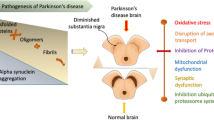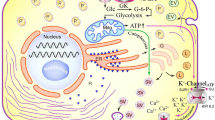Abstract
Activation of the dopamine (DA) D2 receptor inhibits glucose-stimulated insulin secretion in isolated rodent islets in vitro; however, no information is available regarding the cellular localization of DA receptors (DRs, including D1-D5 receptors) in pancreatic islets in situ. We investigate the protein expression and cellular localization of five types of DRs in pancreatic islets by means of Western blotting and double-labeling immunofluorescence in both normal control and alloxan-induced type 1 diabetes model (T1DM) rats. In control rats, D1 immunoreactivity (-IR) was distributed in the core of the islet and co-localized with insulin-IR, D2-IR was peripherally distributed and found only in somatostatin-immunoreactive cells and D5-IR was co-localized with glucagon-IR and pancreatic polypeptide-IR. No IR for either the D3 or D4 receptor was observed in rat islets. The protein level of the D1 receptor was reduced in T1DM rats (D1/D-glyceraldehyde-3-phosphate dehydrogenase [GAPDH], 0.63 ± 0.05 in control rats compared with 0.16 ± 0.03 in T1DM rats, n = 8, P < 0.05) but no significant alteration was detected in the protein expression of either the D2 receptor (D2/GAPDH, 0.48 ± 0.04 compared with 0.43 ± 0.04, n = 8, P = 0.42) or the D5 receptor (D5/GAPDH, 0.50 ± 0.04 compared with 0.47 ± 0.04, n = 8, P = 0.58). The present study is the first clear demonstration of the protein expression and cellular localization of the D1, D2 and D5 receptors in rat pancreatic islets and provides crucial morphological evidence for further investigations of the underlying mechanism regarding the DA regulation of pancreatic endocrine function.






Similar content being viewed by others
References
Ahren B, Lundquist I (1985) Effects of L-dopa-induced dopamine accumulation on 45Ca2+ efflux and insulin secretion in isolated rat islets. Pharmacology 30:71–82
Bousquet M, St-Amour I, Vandal M, Julien P, Cicchetti F, Calon F (2012) High-fat diet exacerbates MPTP-induced dopaminergic degeneration in mice. Neurobiol Dis 45:529–538
de Leeuw WJE, Parlevliet ET, Maechler P, Havekes LM, Romijn JA, Ouwens DM, Piji H, Guigas B (2010) The dopamine receptor D2 agonist bromocriptine inhibits glucose-stimulated insulin secretion by direct activation of the alpha2-adrenergic receptors in beta cells. Biochem Pharmacol 79:1827–1836
DeFronzo RA (2011) Bromocriptine: a sympatholytic, D2-dopamine agonist for the treatment of type 2 diabetes. Diabetes Care 34:789–794
Ericson LE, Håkanson R, Lundquist I (1977) Accumulation of dopamine in mouse pancreatic B-cells following injection of L-DOPA. Localization to secretory granules and inhibition of insulin secretion. Diabetologia 13:117–124
García-Tornadú I, Ornstein AM, Chamson-Reig A, Wheeler MB, Hill DJ, Arany E, Rubinstein M, Becu-Villalobos D (2010) Disruption of the dopamine d2 receptor impairs insulin secretion and causes glucose intolerance. Endocrinology 151:1441–1450
Ghorbani A, Abedinzad M (2013) Comparison of in vitro and in situ methods for studying lipolysis. ISRN Endocrinol 2013:205385
Goldberg LI (1972) Cardiovascular and renal actions of dopamine: potential clinical applications. Pharmacol Rev 24:1–29
Hashimoto K, Inoue T, Higashi T, Takei SI, Awata T, Katayama S, Takagi R, Okada H, Matsushita S (2009) Dopamine D1-like receptor antagonist, SCH23390, exhibits a preventive effect on diabetes mellitus that occurs naturally in NOD mice. Biochem Biophys Res Commun 383:460–463
Havel PJ, Taborsky GJ Jr (1989) The contribution of the autonomic nervous system to changes of glucagon and insulin secretion during hypoglycemic stress. Endocr Rev 10:332–350
Hong F, Liu L, Fan RF, Chen Y, Chen H, Zheng RP, Zhang Y, Gao Y, Zhu JX (2013) New perspectives of vesicular monoamine transporter 2 chemical characteristics in mammals and its constant expression in type 1 diabetes rat models. Transl Res 163:171–82
Inaba K, Witmer-Pack M, Inaba M, Hathcock KS, Sakuta H, Azuma M, Yagita H, Okumura K, Linsley PS, Lkehara S, Muramatsu S, Hodes RJ, Steinman RM (1994) The tissue distribution of the B7-2 costimulator in mice: abundant expression on dendritic cells in situ and during maturation in vitro. J Exp Med 180:1849–1860
Lacy PE, Kostianovsky M (1967) Method for the isolation of intact islets of Langerhans from the rat pancreas. Diabetes 16:35–39
Melkersson K, Khan A, Hilding A, Hulting AL (2001) Different effects of antipsychotic drugs on insulin release in vitro. Eur Neuropsychopharmacol 11:327–332
Morris JK, Seim NB, Bomhoff GL, Geiger PC, Stanford JA (2011) Effects of unilateral nigrostriatal dopamine depletion on peripheral glucose tolerance and insulin signaling in middle aged rats. Neurosci Lett 504:219–222
Patel YC (1999) Somatostatin and its receptor family. Front Neuroendocrinol 20:157–198
Pijl H, Ohashi S, Matsuda M, Miyazaki Y, Mahankali A, Kumar V, Pipek R, Iozzo P, Lancaster JL, Cincotta AH, DeFronzo RA (2000) Bromocriptine: a novel approach to the treatment of type 2 diabetes. Diabetes Care 23:1154–1161
Pressley JC, Louis ED, Tang MX, Cote L, Cohen PD, Glied S, Mayeux R (2003) The impact of comorbid disease and injuries on resource use and expenditures in Parkinsonism. Neurology 60:87–93
Rubí B, Ljubicic S, Pournourmohammadi S, Carobbio S, Armanet M, Bartley C, Maechler P (2005) Dopamine D2-like receptors are expressed in pancreatic beta cells and mediate inhibition of insulin secretion. J Biol Chem 280:36824–36832
Sandyk R (1993) The relationship between diabetes mellitus and Parkinson's disease. Int J Neurosci 69:125–130
Scranton R, Cincotta A (2010) Bromocriptine-unique formulation of a dopamine agonist for the treatment of type 2 diabetes. Expert Opin Pharmacother 11:269–279
Shankar E, Santhosh KT, Paulose CS (2006) Dopaminergic regulation of glucose-induced insulin secretion through dopamine D2 receptors in the pancreatic islets in vitro. IUBMB Life 58:157–163
Song J, Zheng LF, Zhang XL, Feng XY, Fan RF, Sun L, Hong F, Zhang Y, Zhu JX (2014) Upregulation of β1-adrenoceptors is involved in the formation of gastric dysmotility in the 6-hydroxydopamine rat model of Parkinson's disease. Transl Res. doi:10.1016/j.trsl.2014.01.001
Strowski MZ, Parmar RM, Blake AD, Schaeffer JM (2000) Somatostatin inhibits insulin and glucagon secretion via two receptor subtypes: an in vitro study of pancreatic islets from somatostatin receptor 2 knockout mice. Endocrinology 141:111–117
Taborsky GJ, Ahrén B, Havel PJ (1998) Autonomic mediation of glucagon secretion during hypoglycemia: implications for impaired alpha-cell responses in type 1 diabetes. Diabetes 47:995–1005
Ustione A, Piston DW (2012) Dopamine synthesis and D3 receptor activation in pancreatic β-cells regulates insulin secretion and intracellular [Ca2+] oscillations. Mol Endocrinol 26:1928–1940
Vieira E, Salehi A, Gylfe E (2007) Glucose inhibits glucagon secretion by a direct effect on mouse pancreatic alpha cells. Diabetologia 50:370–379
Wendt A, Birnir B, Buschard K, Gromada J, Salehi A, Sewing S, Rorsman P, Braun M (2004) Glucose inhibition of glucagon secretion from rat α-cells is mediated by GABA released from neighboring β-cells. Diabetes 53:1038–1045
Yoshimura K, Shigeura T, Matsumoto D, Sato T, Takaki Y, Aiba-kojima E, Sato K, Inoue K, Nagase T, Koshima I, Gonda K (2006) Characterization of freshly isolated and cultured cells derived from the fatty and fluid portions of liposuction aspirates. J Cell Physiol 208:64–76
Zhang XH, Zhang XF, Zhang JQ, Tian YM, Xue H, Yang N, Zhu JX (2008) β-Adrenoceptors, but not dopamine receptors, mediate dopamine-induced ion transport in late distal colon of rats. Cell Tissue Res 334:25–35
Acknowledgement
This work was supported by the National Natural Science Foundation of China (81170346 and 81370482), Beijing Natural Science Foundation (7132017 and 7121003) and The Project of Construction of Innovative Teams and Teacher Career Development for Universities and Colleges under Beijing Municipality (IDHT20140514). All the authors have read the journal's policy on conflicts of interest and have none to declare.
Author information
Authors and Affiliations
Corresponding author
Additional information
Ye Chen and Feng Hong contributed equally to this work.
Electronic supplementary material
Below is the link to the electronic supplementary material.
Fig. S1
Cross-reactivity between secondary antibodies. a-c. The primary antibodies for the D1, D2 and D5 receptors isolated from the rabbit were treated with DAR (anti-rabbit secondary antibodies isolated from the donkey). d-f. The primary antibodies for the D1, D2 and D5 receptors isolated from the rabbit were treated with DAM (anti-mouse secondary antibodies isolated from the donkey). g-i. The primary antibodies for the D1, D2 and D5 receptors isolated from the rabbit were treated with GAR (anti-rabbit secondary antibodies isolated from the goat). j-l. The primary antibodies for the D1, D2 and D5 receptors isolated from the rabbit were treated with GAM (anti-mouse secondary antibodies isolated from the goat). Nuclei appear blue (DAPI staining). Scale bar: 100 μm (JPEG 336 kb)
ESM 2
(DOC 33 kb)
Rights and permissions
About this article
Cite this article
Chen, Y., Hong, F., Chen, H. et al. Distinctive expression and cellular distribution of dopamine receptors in the pancreatic islets of rats. Cell Tissue Res 357, 597–606 (2014). https://doi.org/10.1007/s00441-014-1894-9
Received:
Accepted:
Published:
Issue Date:
DOI: https://doi.org/10.1007/s00441-014-1894-9




